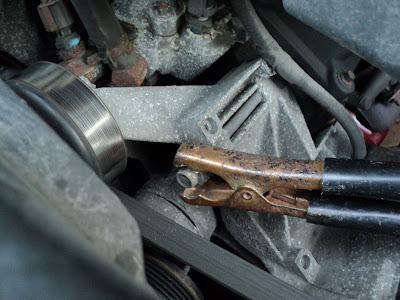My workshop has a sink where I can do the sort of washing up chores that are best not done in more refined environs. What I lack, though, is a faucet that I can connect a hose to for things like my
faucet test fixture. I've thought of a way to add such a faucet to the workshop's sink without having to make a full-blown plumbing project of it, with all the attendant hassle of shutting off the house's water and all. We'll see how it goes.
- - -
The Unorthodox PartI've made up the bits needed to make possible what I have in mind. Here's a view of them.

The 3"long 1/2" NPT pipe nipple was drilled through at two places and tapped 1/4"-20. The undersize 1/4" flat washers are No. 8 washers that I bored out. In back are a steel flat mounting plate and a hardwood spacer.
I'll assemble the pipe nipple to the steel flat with Permatex Ultra Grey RTV gasket maker, and then I'll have the basis for my faucet installation.
- - -
And here it is assembled.

Now I can attach the nipple to the edge of a stud that's right by the sink, and add a faucet.
- - -
And here it is in place at the sink.

I haven't connected it to its water supply yet. That connection will be a 3/8" compression fitting connection. The 1/2" F.I.P. (Female Iron Pipe) hose connection at the right side of the photo raises an interesting point about pipe threads.
- - -
Pictured below are two examples of 1/2" M.I.P. (Male Iron Pipe) threads, along with a 1/2" F.I.P. hose-end fitting.

Pipe threads for assembling pressure-tight joints with Teflon tape, or some other thread sealant, are tapered, so the male and female threads will wedge together as a joint is tightened. (The taper is 1 in 16 as measured on the external diameter.) The fitting at the right in the above photo has a tapered thread.
At the centre is the supply fitting of a Moen faucet. The thread is the same size and pitch (1/2" pipe; 14 tpi), but the thread is straight, not tapered. That's the style of thread that the gasketed hose-end fitting at the left is
meant to go onto, but the hose-end fitting also works fine with a tapered thread -- the fitting's gasket engages the end of a tapered-thread fitting well before the increasing diameter of the thread can interfere with the hose-end fitting's fit. That simplified things a bit here in that I was able to use a readily available tapered thread fitting for this; I didn't have to search for a straight thread fitting.
- - -
ProblemI hooked up the hose faucet just for a pressure test, and there's a leak.

I can't say that I'm surprised by that.
Assembling tapered pipe threads is problematical when the nature of the assembly calls for a specific angular position to be achieved, as was the case here. The copper sub-assembly had to end up with the hose-end fitting pointing down. Once I got it more-or-less snug that way, it didn't feel to me like there was one more full turn to be had from the threaded fitting, so I left it at that. As it's turned out, one more full turn would have been in order.
I'll take that fitting apart and reassemble it with silicone RTV gasket maker for a thread sealant. Once that stuff cures, it'll be end-of-problem.
- - -
Another ProblemUnderneath, where the faucet supply valve resides, I had had in mind to install a tee compression fitting to supply the additional faucet, like so.

That didn't work out. I could not get the compression joints at the short length of plated copper tubing to seal properly. (See
this post for some lessons learned about compression fittings.)
Time for a rethink. Here's what I came up with.

From left to right, we have the following items:
a) A 12" faucet supply hose with a 3/8" compression fitting at the end you can't see, and a 1/2" F.I.P. fitting that you can see.
b) A 1/2" to 1/8" pipe thread adapter that's had its 1/8" pipe thread bored out to 3/8".
c) A 3/8" compression fitting nut.
d) A 3/8" compression sleeve.
e) A 7/8" length of hard, thin-walled brass tubing.
f) The 3/8" compression tee seen in the previous photo.
And here is all that assembled, soldered and cleaned up.

And here it is installed and pressurized.

The outlet for the hose faucet is capped. Tomorrow, the RTV gasket maker in the pipe threads will have fully cured. I can do the final hook-up and I'll have my indoor hose faucet.
- - -
And here it is all together and working.

Now I can attach a hose indoors for connecting any sort of pressure-test fixture, and the faucet is high enough for filling a big bucket if need of that should arise.
Whatever Rouge River Workshop wants, Rouge River Workshop can fabricate.
# # #
# # #
 ('Sorry about the dreadful lighting. Some things can be incredibly difficult to light properly.) I installed two identical hose clamps with their heads opposite one another, and tightened them very securely, like so. It got the job done. (If you'd care to see that, it's 'Addendum II' to this post -- scroll way down.)
('Sorry about the dreadful lighting. Some things can be incredibly difficult to light properly.) I installed two identical hose clamps with their heads opposite one another, and tightened them very securely, like so. It got the job done. (If you'd care to see that, it's 'Addendum II' to this post -- scroll way down.) I took the hose clamps off this morning, and there was no evidence of the chuck having loosened at all.
I took the hose clamps off this morning, and there was no evidence of the chuck having loosened at all.




































